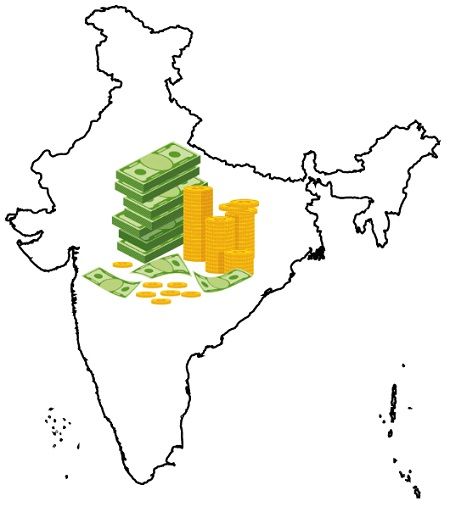 Do you know that National Income is the accurate yardstick of how effectively the economy is performing? Therefore, it is very important to measure the national income of the country, as it portrays a clear picture of the soundness of the economy. Also, it determines the level of economic activity in a country. Simply put, it is the total income of the nation. It is the monetary value of the final goods and services produced in a particular period.
Do you know that National Income is the accurate yardstick of how effectively the economy is performing? Therefore, it is very important to measure the national income of the country, as it portrays a clear picture of the soundness of the economy. Also, it determines the level of economic activity in a country. Simply put, it is the total income of the nation. It is the monetary value of the final goods and services produced in a particular period.
Per Capita Income of the country represents income per head of the population of the respective country. This means the per capita income of a geographical area indicates the total income which each person in that area earns. It gives us an idea of the average standard of living of the people.
The economic welfare of the country relies on the national income and average standard of living to a great extent. In this post, we will explain the differences between national income and per capita income.
Content: National Income Vs Per Capita Income
Comparison Chart
| Basis for Comparison | National Income | Per Capita Income |
|---|---|---|
| Meaning | National Income refers to the aggregate value of the final output of a country of all the new goods and services produced in a year. | Per Capital Income is the total income earned by a person from various sources, during a financial year, of the annual income that a country generates. |
| Related to | Macro Economics | Micro Economics |
| Concept | Absolute Concept | Relative Concept |
| Increase | It increases when there is optimum utilization of the country's resources available in nature. | It increases when the national income grows at a higher rate than the growth in the country's population. |
| Measure | Nation's Economic Performance in a financial year | Human Development Index |
What is National Income?
National Income (NI) is the sum total of all the income accruing to the country’s citizens, be it compensation to employees, operating surplus or mixed income. Simply put, it is the total income a nation earns from different economic activities. It is highly related to national products.
It can be defined in three ways, i.e. three different points of view:
- Output: NI implies the aggregate market value of the final goods and services produced in a country and income from abroad during a financial year.
- Income: National income is the total factor income of the country’s normal residents earned during a financial year.
- Expenditure: Total amount of expenditure incurred on the final goods and services by the normal residents of a country during the financial year.
Also Read: Difference Between Domestic Income and National Income
Do you know?
In India, the Central Statistical Organization (CSO), a department of the Ministry of Planning and Programme Implementation, is entrusted with the task of estimating the NI.
Types
We can calculate national income at both current prices and constant prices. However, the NI at the current price is not the right indicator of the economic position of the country because it represents the monetary income and not the real income. On the other hand, NI at a constant price is what we call real national income. And it is the index of the country’s economic growth. It reflects the standard of living of the citizens.
A rise in the NI at the current price can take place due to the rise in the price of goods and services. However, there may not be any real increase in the quantity of goods and services produced. However, the rise in the national income at a constant price takes place due to the rise in the actual output of goods and services.
- Monetary National Income: It is nothing but the NI at current prices. In this, the valuation of the output produced during the financial year in a country takes place at the prevailing prices of the year.
- Real National Income: It is the NI at constant prices. In this, the valuation of the output produced during the financial year in a country takes place at the prices of the base year. In this way, the valuation of output is at a constant price.
To convert monetary national income into real national income, we can use this formula:
Importance
Well, the study of national income is important because:
- It is a true indicator of the economic development of the country.
- Also, it reflects the contribution of different sectors to the national income.
- It performs a benchmark to measure the progress of the nation.
- It helps in making comparisons among different countries.
- Provides data for national-level economic planning.
Also Read: Difference Between Economic Growth and Economic Development
Use of NI Estimates
National Income estimates are helpful in the following:
- Measurement of economic growth
- Calculation of per capita income
- Evaluating the performance of various sectors
- Identifying the inequalities in the income distribution
- Measuring the standard of living
- Indicating the level of investment and pattern as well.
- Disclosing the consumption behaviour of society.
Also Read: Difference Between Cost of Living and Standard of Living
What is Per Capita Income?
Per Capita Income implies how much an individual earns of the annual income that a country generates through productive activities. It refers to the share of each person when the total national income generated from productive sources is divided equally among the total citizens. We can calculate it by dividing the Total NI by the Total Population of the country.
An alternative term for per-capita income is average income. This is because it determines the average income of a person in an area. Hence, it indicates the quality and standard of living of people in that particular area.
It measures the wealth of the country’s population when it is compared to other countries. Therefore, the Word Bank uses this measure to classify nations into different categories – developed countries and undeveloped countries.
Also Read: Difference Between Developed Countries and Developing Countries
Formula
To calculate per capita income, we can use this formula:
Example
Suppose the total income of a city is Rs. 5,00,00,000, and the total population of the city is 2,50,000 people. So, the per capita income of that city is Rs. 2,000.
Types
We can calculate per capita income both at the current price and constant price.
- Monetary per capita Income: Per capita income at the current price indicates monetary income. It is not a true indicator of real income. This is because the rise in the monetary income may happen due to the rise in the price and wage rates, but there is no rise in the quantity of output.
- Real Per capita income: It is the per capita income with regard to real products and services. It is the per capita income at constant prices.

Importance
- It is an index of economic welfare and economic development.
- It helps us to know the average income and standard of living of people in an area on average.
- An increase in the per capita income reflects the improvement in the living standard of the people and economic development in that area.
Also Read: Difference Between GDP and GNP
Key Differences Between National Income and Per Capita Income
- The per capita income reflects the economic output of the country per person. On the other hand, national income is the total income of normal residents of a nation during a financial year.
- While the former is related to macroeconomics, as macroeconomics is the study of aggregates. The latter is related to microeconomics, as microeconomics is the study of individual units.
- National Income is an absolute concept. Whereas Per Capita Income is a relative concept.
- The National Income of the country increases when there is optimum utilization of the country’s factors of production. Conversely, Per Capita Income increases when the national income grows at a higher rate than the growth in the population of the country.
- National Income is a true indicator of the Nation’s Economic Performance in a financial year. On the other hand, Per Capita Income plays a significant role in the measurement of the Human Development Index. HDI is an index that measures the improvement in the basic aspects of human development. These aspects are long and healthy life, a good standard of living and being knowledgeable.
Conclusion
Summing up, national income includes per capita income. The former indicates the monetary value of the net contribution of all the economic resources, i.e. factors of production in the country and abroad. Per Capita Income is calculated by dividing the national income by the size of the population.







Leave a Reply